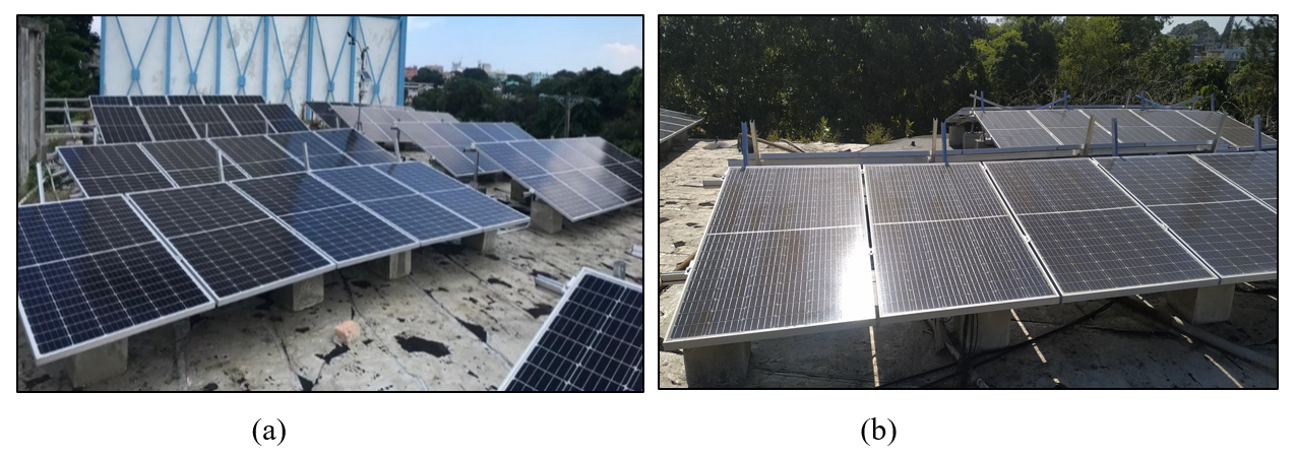Experimental determination of the performance loss of a photovoltaic panel due to deposited particulate material.
Main Article Content
Abstract
Atmospheric particulate matter deposited on the surfaces of solar panels decreases their electricity production by reducing the transmission of solar energy to the photovoltaic cells. The performance of the photovoltaic panel (or module) refers to the actual efficiency once installed and takes into account factors such as dirt (deposited particulate matter), climate, orientation, temperature, etc. The objective of this work is to experimentally determine the loss of performance of photovoltaic panels due to deposited particulate material. The normalized current-voltage (IU) curve was carried out on four monocrystalline silicon half-cell panels, exposed for 8 and 13 months, in dirty conditions and after cleaning them. In all cases, the particulate material was recognized for its subsequent mass determination and elemental characterization. The main preliminary results obtained were: linear dependence relationship, with negative slope and R2 = 0.9672, between the performance loss and the mass per unit area of the powder deposited on the panel and for an average deposited mass of 0.46 g/ m2, the performance of the panels studied is reduced by around 1.7% where, if the manufacturer's efficiency reference value of 19.85% is taken as 100%, this means an 8.5% reduction in its generation due to material contamination. deposited particulate. The increase in maximum power (PM), short circuit current (Isc) and open circuit voltage (Voc) will be observed in all cases after cleaning the panel.
Downloads
Article Details

This work is licensed under a Creative Commons Attribution-NonCommercial 4.0 International License.
Those authors who have publications with this journal accept the following terms of the License Attribution-NonCommercial 4.0 International (CC BY-NC 4.0):
You are free to:
- Share — copy and redistribute the material in any medium or format
- Adapt — remix, transform, and build upon the material
The licensor cannot revoke these freedoms as long as you follow the license terms.
Under the following terms:
- Attribution — You must give appropriate credit, provide a link to the license, and indicate if changes were made. You may do so in any reasonable manner, but not in any way that suggests the licensor endorses you or your use.
- NonCommercial — You may not use the material for commercial purposes.
- No additional restrictions — You may not apply legal terms or technological measures that legally restrict others from doing anything the license permits.
The journal is not responsible for the opinions and concepts expressed in the works, they are the sole responsibility of the authors. The Editor, with the assistance of the Editorial Committee, reserves the right to suggest or request advisable or necessary modifications. They are accepted to publish original scientific papers, research results of interest that have not been published or sent to another journal for the same purpose.
The mention of trademarks of equipment, instruments or specific materials is for identification purposes, and there is no promotional commitment in relation to them, neither by the authors nor by the publisher.
References
Andrea, Y., Pogrebnaya, T., & Kichonge, B. (2019). Effect of industrial dust deposition on photovoltaic module performance: Experimental measurements in the Tropical Region. Hindawi International Journal of Photoenergy, 10.
Angulo, J. (2020). Estudio del efecto del polvo y estimación de la portencia nominal en un string fotovoltaico. TECNIA, 30.
Bergin, M. H. (2017). Large reductions in solar energy production due to dust andparticullate air pollution. Environmental Science & Technology Letters, Vol 4, 339-344.
González, E., Hernández, I. L., López, R., & González, C. M. (2023, enero-diciembre). Dispersión de contaminantes atmosféricos en La Habana de 1994 a 2020. Cub@: Medio Ambiente y Desarrollo, 23, 10.
IEA PVPS. (2018). Review on Infrared and Electroluminiscence Imaging for PV Fields Applications. IEA.
IEA-PVPS. (2014). Report IEA-PVPS T13-01:2014, Review of Failures of Photovoltaic Modules.
IEC TS 62446-3. (2017-06). IEC TS 62446-3 Photovoltaic (PV) systems – Requirements for testing, documentation and maintenance – Part 3: Photovoltaic modules and plants – Outdoor infrared thermography. Edition 1.0.
IEC 60891. (2009-12). INTERNATIONAL STANDARD Photovoltaic devices – Procedures for temperature and irradiance corrections to measured I-V characteristics. . Edicion 2.0.
IEC TS 60904-13. (2018-08). Photovoltaic devices – Part 13: Electroluminescence of photovoltaic modules. Edition 1.0.
IEC TS 60904-14. (2020). Photovoltaic devices - Part 14: Guidelines for production line measurements of single-junction PV module maximun power output and reporting at standard test conditions.
Köntges, M., Kurtz, S., Packard, C. E., Jahn, U., Berger, K., Kato, K., . . . Van Iseghem, M. (2014). Review of failures of photovoltaic modules. Report IEA PVPS T13 01:2014.
Martín Buenaposada, Á., González Rebollo, M., & Moretón Fernández, A. (2021). Desarrollo de un prototipo para medidas de electroluminiscencia en paneles solares. Tesis, Universidad de Valladolid. Valladolid: Tesis para optar por el grado de Ingeniería Eléctrica.
Navarret, K. P. (2019). Análisis técnico-económico de un sistema fotovoltaico con influencia de suciedad, viento y lluvia en Arequipa-Perú. Tesis para Título Profesional de Ingeniera Industrial. Facultad de Ingeniería, Universidad Tecnológica del Perú.
OMM. (1992). Vocabulario Meteorológico Internacional. Ginebra: Organización Meteorológica Mundial.

